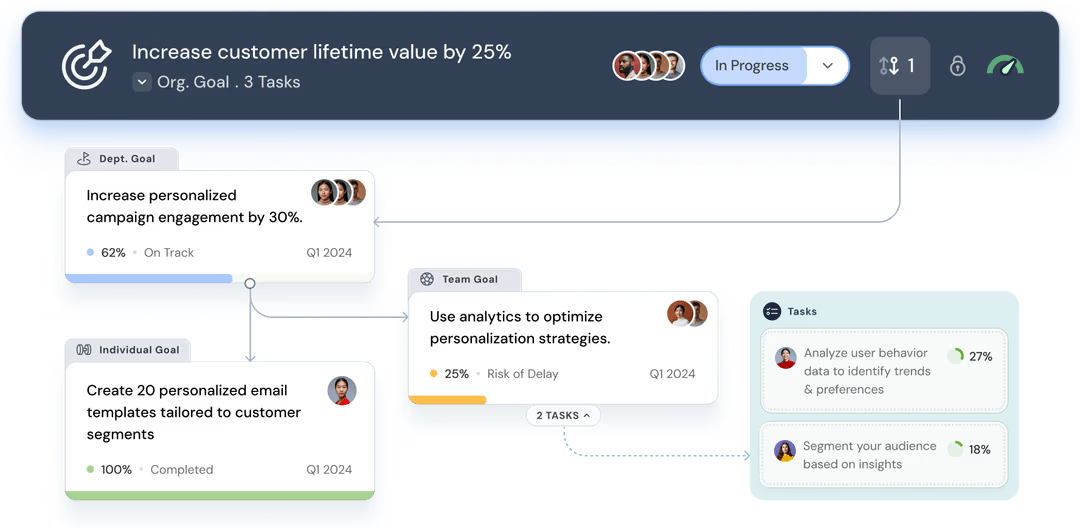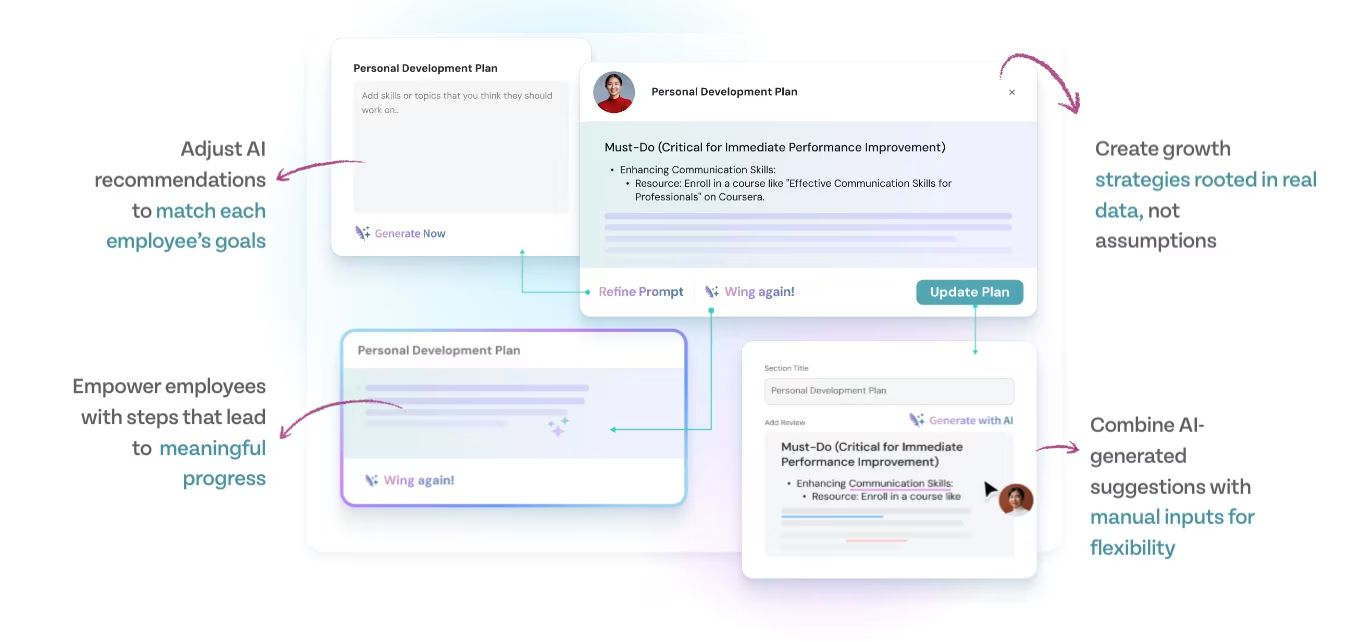Digital transformation is not just about adopting the latest technology, but aligning it with your company’s strategy, people, and processes to drive growth. While global spending on digital transformation is projected to hit nearly $4 trillion by 2027, about 70% of initiatives fail due to poor planning and low user adoption. Clear, strategic goals help businesses avoid waste and seize opportunities.
Companies embracing AI, cloud, and analytics—expected to be around 75% in the near future—often see 2 to 6 times higher shareholder returns. Setting meaningful goals ensures technology investments translate into real outcomes and long-term success.
If you’re ready to lead your company through digital transformation, this blog will share what it truly means, why goals matter, and 10 proven objectives to drive impactful results.
What is digital transformation and why do goals matter?
Digital transformation is the integration of digital technology into every part of your business, fundamentally changing how you operate and deliver value to your customers. But it’s not just about buying the latest tools—it’s a mindset shift that challenges the way your organization thinks, works, and innovates.
Digital transformation is essential to stay competitive, improve efficiency, and respond quickly to market changes. However, simply adopting new technologies isn’t enough. Clear, well-defined goals are crucial because they keep your efforts focused, measurable, and aligned with your broader business objectives.
Without these goals, even the smartest tech can fall flat, leaving you with wasted resources and missed opportunities. Setting goals ensures everyone—from leadership to frontline teams—is moving together toward meaningful outcomes.
How to set effective digital transformation goals
- Assess Digital Maturity and Needs:
Begin by evaluating your organization’s current digital maturity and true technology requirements. This helps avoid overspending on unnecessary solutions.
- Secure Buy-In from Leaders and Employees:
Ensure everyone understands the purpose of the transformation and feels motivated to contribute. Alignment is key.
- Use Proven Goal-Setting Frameworks:
Employ frameworks like SMART goals and OKRs to turn big ambitions into clear, actionable targets.
- Define Metrics and KPIs:
Establish measurable indicators such as NPS (Net Promoter Score), cycle time, and employee engagement to monitor progress effectively.
- Leverage Tools for Alignment and Tracking:
Use solutions like ThriveSparrow’s Goals (OKRs) module to align individual objectives with company-wide priorities and track performance in real time.

By following this structure, you build alignment, boost adoption, and maximize the value of your digital investments—laying a strong foundation for successful digital transformation.
10 Digital Transformation Goals for Sustainable Growth
The following goals reflect emerging trends and insights from research and competitor analysis. They cover customer, operational, employee and societal dimensions to ensure your transformation delivers lasting value.
For broader context on digital transformation, see recent thought leadership including UNCTAD’s Digital Economy Report 2024.
1. Deliver frictionless and personalised customer experiences
Why it matters
Most competitor articles rank customer experience as the top objective, and for good reason: meeting customer needs leads to higher revenue and profit margins. Express Computer underscores the rise of hyper‑personalisation, where AI‑powered tools adapt experiences in real time. Data‑driven, omnichannel experiences delight customers and encourage loyalty.
How to achieve it
- Map customer journeys to understand pain points and opportunities. Invest in AI‑driven analytics and recommendation engines to predict preferences and personalise interactions.
- Use intelligent chatbots and self‑service portals to provide 24/7 support. According to TechTarget, modern customer‑service systems enable agents to find customer information quickly and resolve issues faster.
- Empower frontline employees with real‑time feedback tools like ThriveSparrow’s Pulse Surveys. Quick feedback loops reveal friction points and allow you to adjust service processes rapidly.
Spot and solve workplace friction—try ThriveSparrow’s Pulse Surveys free for 14 days.
Metrics to Track
Track Net Promoter Score (NPS), customer satisfaction (CSAT) and support response times.
For readers seeking external perspectives on customer experience, Forrester’s Predictions 2024: Customer Experience report provides data‑backed insights into evolving customer expectations and how digital transformation drives loyalty.
2. Drive agility and continuous innovation
Why it matters
In a world of constant change, agility is a competitive necessity. Digital‑Adoption notes that an agile organisation features empowered teams, rapid decision cycles and next‑generation technology.
How to achieve it
- Adopt cloud‑first architectures, modular platforms and DevOps/CI‑CD pipelines to scale quickly and release new features often.
- Foster a culture of innovation by encouraging experimentation and learning from failure; provide tools for idea sharing and rapid prototyping.
- Integrate AI into areas like product design, marketing, HR and finance to automate tasks and uncover insights. WalkMe reports that 75 % of companies plan to adopt AI and analytics in the coming years.
Metrics to Track
Measure deployment frequency, time‑to‑market and the share of revenue from new products or services.
When agility becomes part of your company’s DNA, you’re ready to adapt to any market shift and seize new opportunities as they arise. The next priority: operational efficiency that frees up resources for further growth.
3. Streamline operations and process efficiency
Why it matters
Automating manual processes frees employees from repetitive tasks and reduces errors. TechTarget notes that eliminating manual re‑keying and introducing automated approvals improves worker performance. Automating accounts payable and other back‑office functions not only reduces costs but also improves reporting and compliance.
How to achieve it
- Map existing processes, identify bottlenecks and prioritise tasks for automation. Use robotic process automation (RPA), low‑code tools and AI to handle repetitive tasks.
- Standardise workflows across departments to reduce hand‑offs and re‑work.
- Provide training so employees can adapt to new systems. Whatfix warns that lacking user adoption is one of the main reasons digital transformations fail; change‑management initiatives and continuous learning are also essential.
Metrics to Track
Track cycle time reductions, automation rates and cost savings.
Efficient processes are the backbone of any scalable business. With operations streamlined, companies can shift focus to maximizing returns and minimizing waste in the next phase.
4. Reduce costs while increasing return on investment
Why it matters
Cost reduction remains a classic objective of digital transformation. Digital‑Adoption highlights that automation and AI can reduce labour costs in call centres and administrative functions. WalkMe adds that companies with strong digital and AI skills earn two to six times higher shareholder returns than their peers.
How to achieve it
- Consolidate your technology stack and leverage cloud platforms to eliminate duplicate systems and reduce capital expenditures.
- Invest in predictive analytics to identify cost‑saving opportunities, such as optimising energy use or reducing inventory.
- Focus on quick wins that deliver early ROI to build confidence and fund further initiatives.
Metrics to Track
Monitor cost savings and the ROI of digital projects.
For a data‑driven view of how digital initiatives translate into financial returns, WalkMe’s compilation of Digital Transformation Statistics for 2025 summarises spending forecasts and shareholder returns across industries.
5. Empower employees and improve performance
Why it matters
Digital transformation should make employees’ lives easier, not harder. Research shows that fostering a work environment where employees achieve flow can boost productivity by up to 127%. Engaged employees are more productive and stay longer.
How to achieve it
- Provide modern collaboration tools and intuitive interfaces to reduce frustration and context switching.
- Use continuous feedback systems, engagement surveys and analytics to understand how people feel about changes and recognise achievements.
- Support career growth and personal development with AI-powered platforms.
Try ThriveSparrow’s Personal Development Plan—free for 14 days—to support your employees' growth.

Metrics to Track
Track engagement scores, retention and time‑to‑productivity for new hires.
6. Build a data‑driven culture through democratisation and analytics
Why it matters
When data is locked away in silos or limited to executives, decision-making slows down and becomes less effective. Data democratization means making accurate, timely information accessible to everyone—from the CEO to the newest team member. This openness empowers all employees to make informed decisions, fosters collaboration, and drives innovation across the organization. As Express Computer highlights, creating a culture where data flows freely is essential for agility and smarter business outcomes.
How to achieve it
- Invest in modern data platforms that integrate information from disparate systems and enable self‑service analytics.
- Develop a data‑governance framework and train employees to ensure data quality, security and literacy.
- Use dashboards and visual analytics to communicate insights clearly so everyone can interpret and act on data.
Metrics to Track
Track data access across the organisation, data quality and how often data informs decisions.
When everyone has access to the right data at the right time, organizations make smarter, faster decisions.
7. Strengthen governance, security and compliance
Why it matters
As digital initiatives expand, protecting sensitive data and complying with regulations become critical priorities. The rise of internet-connected devices (IoT) significantly increases the potential attack surface, making data security and compliance more challenging yet essential.
Organizations must regularly review their existing data protection strategies to ensure they effectively guard against evolving threats. Clear governance policies are vital to define roles, responsibilities, and processes that uphold data privacy, security standards, and regulatory compliance.
How to achieve it
- Build privacy by design into all projects using encryption, multi‑factor authentication and regular security audits to comply with regulations such as GDPR, HIPAA or local laws.
- Establish governance frameworks and train employees on security best practices so everyone understands their responsibilities and the importance of compliance.
Metrics to Track
Monitor security incidents, audit outcomes and response times.
8. Foster collaboration and create a hybrid‑ready workplace
Why it matters
The pandemic accelerated remote work, but many companies now face challenges in creating equitable experiences for onsite and remote workers. Express Computer describes workplace flexibility 2.0, where hybrid environments feel equally engaging whether employees are in an office or on a beach (expresscomputer.in).
2025 digital transformation goals must therefore include collaboration and hybrid-work readiness.
How to achieve it
- Provide cloud‑based collaboration platforms with real‑time co‑authoring, video conferencing, chat, virtual whiteboards and document management to recreate office interactions.
- Adopt asynchronous communication and cross‑departmental projects—recorded demos, shared notes and rotating teams—to accommodate different time zones and promote knowledge sharing.
- Implement continuous feedback systems like ThriveSparrow’s Feedback to keep teams aligned and engaged no matter where they work.
Try ThriveSparrow’s Feedback module—free for 14 days—to keep teams aligned, no matter where they work.

Metrics to Track
Track collaboration‑tool usage, meeting attendance and productivity parity between remote and onsite teams.
Building a hybrid-ready culture not only future-proofs your organization but also attracts top talent who value flexibility
9. Integrate sustainability and ethical AI
Why it matters
Digital transformation should support both the planet and society. Express Computer emphasizes that environmental responsibility is becoming a core business function, with AI systems helping businesses track and reduce their carbon footprints (expresscomputer.in). It also notes the growing need for ethical AI frameworks that uphold organizational principles and human values (expresscomputer.in).
How to achieve it
- Set sustainability targets—like reducing carbon emissions or improving energy efficiency—and use AI and IoT to monitor energy, waste and emissions in real time.
- Ensure AI models are transparent and free from bias by establishing ethical guidelines for data collection, algorithm design and decision‑making.
Metrics to Track
Track carbon emissions, energy usage and ethical‑AI compliance.
With sustainability and ethics in focus, digital transformation can drive long-term value for both business and society.
10. Build supply‑chain resilience and drive digital product evolution
Why it matters
Global disruptions have exposed vulnerabilities in traditional supply chains. Express Computer highlights that companies are using predictive AI models to spot potential disruptions and suggest alternative suppliers or routes, creating flexible networks.
How to achieve it
- Use digital twins and IoT sensors to monitor assets and supply chains in real time, simulate scenarios and plan contingencies.
- Apply predictive models to forecast demand and disruptions and build flexible networks with alternative suppliers and manufacturing processes.
- Expand your portfolio into digital and hybrid offerings by augmenting physical goods with connected services or AI‑driven user experiences.
Metrics to Track
Track supply‑chain cycle time, inventory turnover and the revenue share from digital products.
Final Thoughts
Digital transformation is no longer optional. With global spending approaching $4 trillion and AI adoption accelerating, companies without clear goals risk wasting resources. The goals above offer a practical roadmap for sustainable growth across customer, operational and societal dimensions.
Success still depends on execution: assess your digital maturity, involve stakeholders, use SMART and OKR frameworks, and track meaningful metrics. Transformation is as much about people and culture as it is about technology—continuous learning, collaboration and ethics will guide your journey.
Ready to start? ThriveSparrow’s AI‑powered employee success platform helps you align goals, gather real‑time feedback and recognise achievements.
Try our full suite—including Goals (OKR), Pulse Surveys, Employee NPS, Feedback and Kudos—free for 14 days and see how ThriveSparrow can support your digital transformation.
FAQ's
1. What are some practical examples of digital transformation goals?
People often ask what specific goals look like. Common examples include reducing customer‑service response time by 30 % with AI chatbots, automating half of invoice approvals, raising employee‑engagement scores via continuous feedback tools or cutting carbon emissions through IoT energy monitors. The key is to set goals that are specific, measurable and tied to business outcomes.
2. How do you measure the success of a digital transformation goal?
Measurement depends on the objective. Customer‑experience goals rely on metrics like NPS or CSAT, operational goals look at cycle time and cost savings, and people‑focused goals track engagement and retention. The important thing is to define KPIs at the outset so you know whether the transformation is working.
3. How do you prioritise digital transformation goals when resources are limited?
Evaluate each initiative’s impact and feasibility. Start with quick wins that generate momentum and free up resources, then tackle more complex projects. Frameworks such as the Eisenhower Matrix (urgent vs. important) help rank tasks.
4. Can small and mid‑size companies pursue the same goals as large enterprises?
Yes. The core objectives—improving customer experience, efficiency and agility—are universal; only the scale differs. Small and mid‑size businesses can leverage cloud‑based software and SaaS tools for a faster, more affordable transformation. Tools like ThriveSparrow provide scalable employee engagement and OKR management without the overhead of enterprise platforms.
5. What role do employees play in achieving digital transformation goals?
Employees are central. Many transformations fail because people resist or don’t adopt new tools. Involve staff early, communicate why change matters, offer training and create feedback loops. Continuous feedback systems like ThriveSparrow’s Pulse Surveys give employees a voice and help leaders adapt quickly.
















